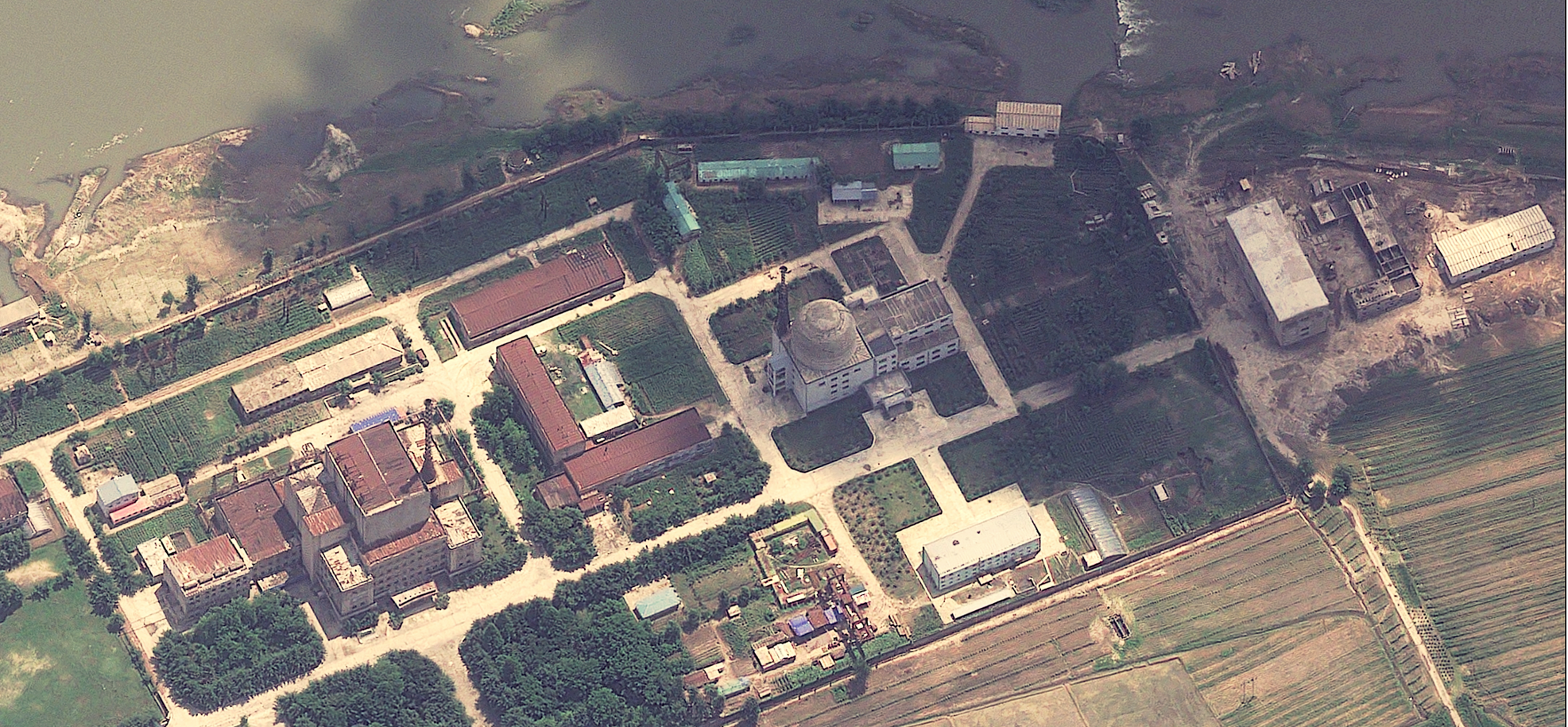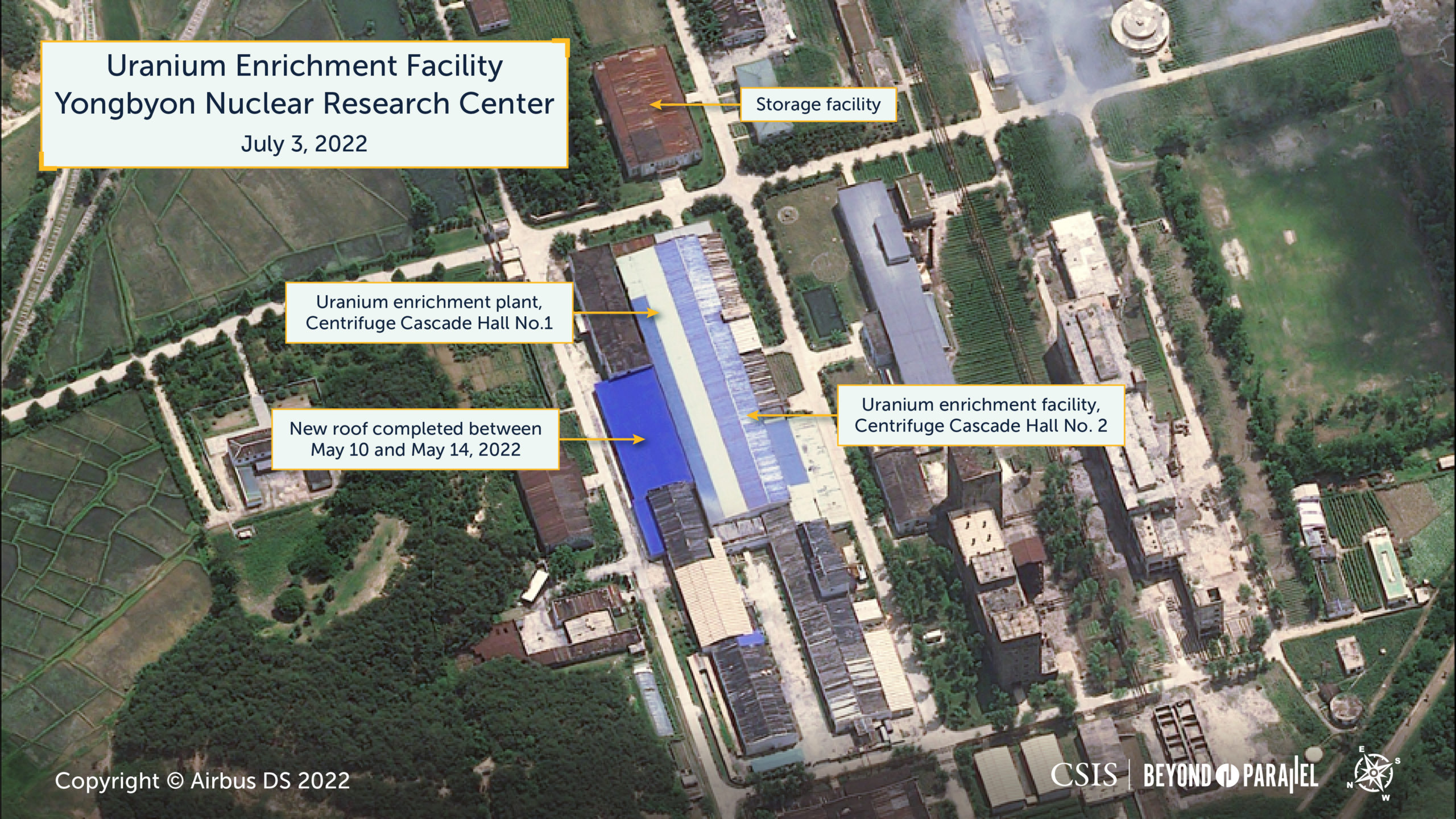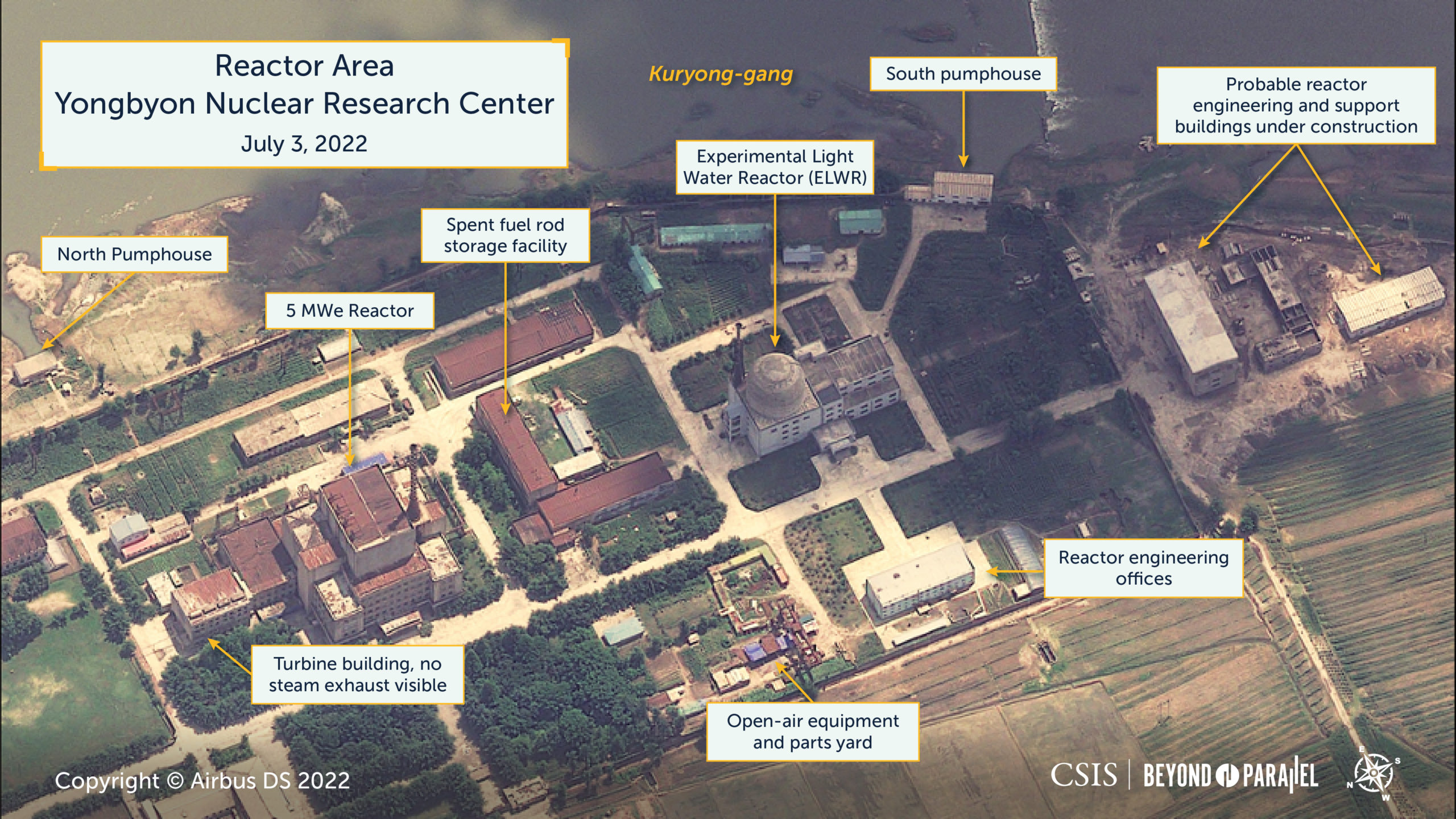
Yongbyon Update: New Activity at Building 500 and Rising Waters
Key Findings
- A high-resolution Pléiades Neo satellite image acquired on July 3, 2022, details the current observable status of the Yongbyon Nuclear Research Center—North Korea’s only declared plutonium and enriched uranium production facility.
- New excavation activity is observed on the west side of Building 500, used to store radioactive and toxic waste produced at the Radiochemistry Laboratory—the first such activity since 2016. Among the potential reasons for this activity are to address structural issues or leakage from the building, an effort to reopen access to the building to accommodate new waste from the Radiochemical Laboratory, or as part of a strategic deception plan.
- Rising waters from recent rains are flooding the Kuryong River that runs through the Yongbyon Nuclear Research Center. None of the buildings within the center are at immediate risk of being flooded. However, it is uncertain how the flooding will impact ongoing operations or if flooding will increase.
- Miscellaneous construction and dismantling activities are observed throughout the center.
As part of Beyond Parallel’s ongoing detailed coverage of North Korea’s WMD and ballistic missile developments, this report presents an update of the currently observable activities at the Yongbyon Nuclear Research Center as of July 3, 2022. While portions of the current image are obscured by clouds and deep shadows, peeking through those clouds and shadows provides unique detailed views of some of the recent activity there.
Kuryong-gang Flooding
During the past several weeks North Korean state media have carried reports concerning heavy rains during late-June causing widespread flooding over large swaths of North Korea—including the Yongbyon area. Images from July 3 and 9 show that these rains have also impacted the Kuryong-gang, which runs through the middle of the Yongbyon Nuclear Research Center. The dam immediately east of the Experimental Light Water Reactor (ELWR), which is used to keep the upstream water level high enough to supply water to cool the reactors, is seen with high water overflowing the dam and its sluiceway. Upstream water fills the channels leading to both the north and south pumphouses. In contrast, immediately downstream of the dam, the channels around a small island and numerous sand/gravel bars along the river are submerged. Likewise, further downstream, the waterworks (i.e., dam, channels, etc.) supporting the center’s southeastern facilities (e.g., uranium enrichment facility, isotope production facility, etc.) and the sand/gravel operations there are also flooded. Water is observed flowing over the dam there, and high-water levels have partially flooded the sand/gravel bars along the outside bend of the river.
None of the buildings within the Yongbyon Nuclear Research Center are at immediate risk of being flooded. However, it is uncertain how the flooding will impact ongoing operations or if the flooding will increase.


Building 500
Building 500 was first openly identified as a storage facility for radioactive and toxic waste produced at the Radiochemistry Laboratory during 1993 and has been watched closely using commercial satellite imagery since the early 2000s as a potential indicator of plutonium production and environmental pollution. Until the present image, significant activity here has only been observed in commercial satellite imagery during April 2016-March 2017, when a large trench was excavated and subsequently filled along its foundation’s east side.
The image collected on July 3, 2022, shows new excavation activity on the building’s west side, leading to an unused bay door. Among the potential reasons for this activity are to address structural issues or leakage from the building, an effort to reopen access to the building to accommodate new waste from the Radiochemical Laboratory, or as part of a strategic deception plan.

50 MWe Reactor
Located approximately 950-meters northeast of the Radiochemistry Laboratory is the never completed 50 MWe Reactor. While there have been a small number of occasional reports over the years of miscellaneous minor activity at the site, none have amounted to anything of long-term significance. In May 2022, Arms Control Wonk first identified new trenching activity immediately east of the reactor site and discussed the potential for some reactivating construction on the reactor. Subsequently, in June, 38 North expanded upon this trenching activity and the likelihood that activity at the abandoned 50 MWe Reactor was for razing the facility.
While clouds obscure the site of the reported trenching in the July 3 image, the 50 MWe Reactor site is visible through the clouds and provides a unique and detailed view of recent activity there. This, and previous images, indicate that a number of structures within the site are in the process of being slowly razed.

Since the 1990s, the large, approximately 25-meter-by-55-meter structure immediately to the east of the main reactor building has stood uncompleted, consisting of a foundation and skeleton framework consisting of approximately 30-40 support columns of various heights. Sometime during June-July 2021, these support columns began to be slowly taken down. The July 3, 2022, image shows all but 16 columns have been taken down and laid on the ground alongside the foundation. Interestingly, none of the recent readily available imagery shows heavy construction equipment engaged in this process, although it undoubtedly was used.
Razing of the approximately 20-meter-by-75-meter spent fuel rod building immediately to the south of the main reactor building began sometime about May 22, 2021, when roof panels at the rear of the building were observed having been removed. By September 1, three-quarters of the roof and exterior walls had been removed, exposing the interior, including what some have identified as the spent fuel rod cooling ponds. Two months later, on November 1, satellite imagery shows that the rear quarter of the building, including foundation, had been razed. Sometime about June 8, 2022, the first signs of work to remove the final quarter of the roof were observed. The July 3, 2022 image shows that dismantling work has continued, with numerous roof panels on the final section having been removed.
The unidentified, approximately 20-meter-by-35-meter support building on the corner southeast of the main reactor building remained relatively untouched until February 2022, when a crane was brought in and began removing the roof and external walls. By late June, this process appears to have been complete, and a crane is no longer present in the July 3 image.
Radiochemistry Laboratory
Since early 2022, vehicles or tucks have occasionally been observed at the Radiochemistry Laboratory’s shipping/receiving building and nearby motor vehicle maintenance and storage buildings. The same is true with the current image from July 3, 2022, with a single large truck present in the motor vehicle maintenance and storage area. No railcars—specialized or otherwise—are present in the July 3 image.


Approximately 500-meters to the southeast of the Radiochemistry Laboratory is the facility’s rail-served thermal (steam) plant. Activity, especially plumes rising from its stack, has often been associated with a planned or ongoing reprocessing campaign. While the thermal plant facility is partially obscured by clouds, no plume or activity of significance is observed in the July 3 image.

The Uranium Enrichment Facility
The only significant development at the uranium enrichment facility noted in the July 3 image has been the completion of a blue roof on the new addition along the north side of Centrifuge Cascade Hall No. 1 sometime between May 10 and May 14. Construction of this approximately 50-meter-by-20-meter addition was begun sometime about September 8, 2021, and likely continues internally. The purpose of this new addition is unknown. It is not practical to determine the operational status of the uranium enrichment facility from the current image alone.

5 MWe Reactor
No activity of significance (e.g., presence of trucks or equipment, etc.) is observed in the July 3 image around the 5 MWe reactor, spent fuel rod storage building, or the adjacent turbine building. It is not practical to determine the operational status from the current image alone.


Experimental Light Water Reactor (ELWR)
Except for two trucks on the north side of the reactor, no significant activity is observed at the ELWR. There are no indications in the image that the reactor has begun operations.

New Support Facility
Approximately 100-meters south of the ELWR, construction of what appears to be a new support area began in late July 2021. At present, the facility encompasses approximately 12,000 square meters and consists of three buildings—two two-story and a single three-story. Two of which appear to be nearing the point of being externally complete. The purpose of this new facility is unknown. However, its location close to the reactors suggests that it is for directly supporting reactor operations.

IRT-DPRK Research Reactor
Located at the north end of the Yongbyon Nuclear Research Center is North Korea’s oldest reactor, the IRT-DPRK, which was provided by the Soviet Union during the 1960s. While originally supplied as an IRT-2000 model reactor, it has been upgraded over the years by North Korean scientists and engineers. As best as can be presently determined, it has only operated intermittently and for short periods of time during the 2000s. The July 3 image provides a detailed close-up view of the reactor. As with the other reactors, it is not practical to determine the operational status of the IRT-DPRK from the current image alone.

